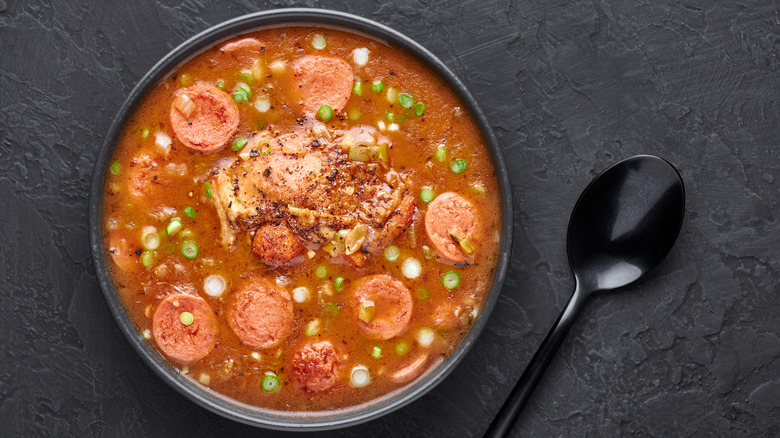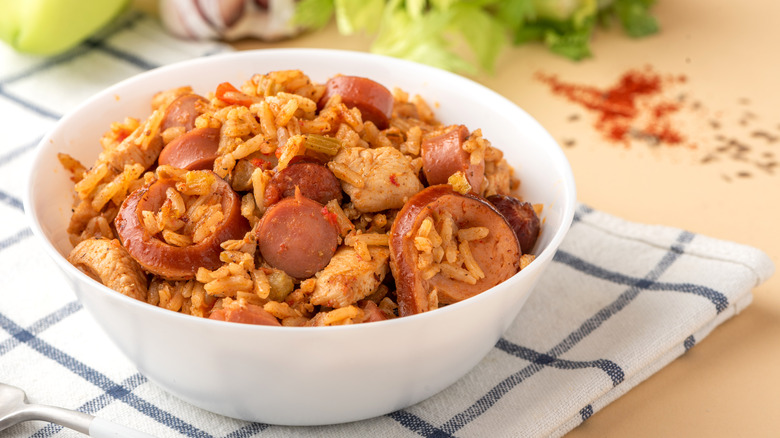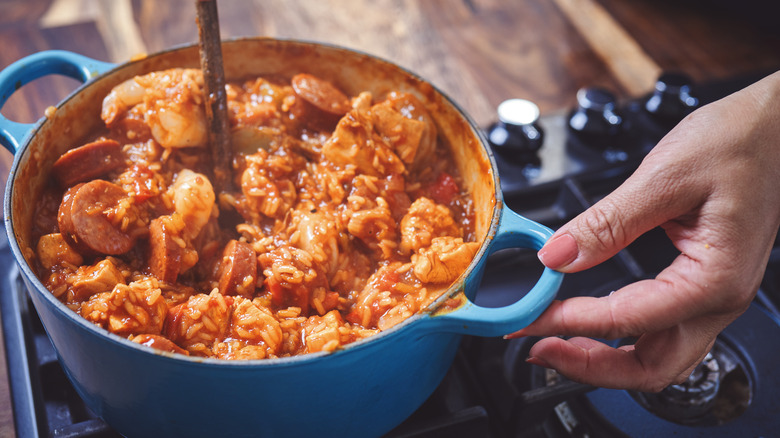The Difference Between Gumbo And Jambalaya Is In One Subtle Detail
American food is ever-evolving and varied and sometimes it is difficult to articulate. So, it helps to break it down into iconic dishes by region or state. There's Tex-Mex food in Texas, Korean-American food in California, deep-dish pizzas in Chicago, and gumbo and jambalaya in Louisiana.
While most of those dishes are distinct, a casual visitor to Louisiana could assume that gumbo and jambalaya are interchangeable. After all, these are two of the most iconic dishes in Louisiana with French, Spanish, African, and Caribbean influences — sometimes referred to as Cajun or Creole influences. They are both hearty soups or stews, strong in flavor, and require a lengthy time to simmer.
But the key difference between the two is the use and role of rice to complement and complete the dish. Gumbo is a stew served with rice — which is cooked separately — while jambalaya is a one-pot dish that incorporates the rice. Think of it as being like the differences between kimchi-jjigae with steamed rice versus congee.
Gumbo is a stew or soup dish served with rice
Gumbo and jambalaya have the same base ingredients and can both be made with a range of proteins, such as chicken, sausage, shrimp, and oysters while the vegetables typically include the "trinity" of onion, celery, and bell pepper. But since rice is incorporated into each dish in a different way, the cooking methods are also different.
The process to make gumbo starts by first making a roux, which hints at French influences. It is a mixture of flour and fat that is cooked until it turns a deep, caramel color. The roux is then used to thicken the broth although some people use okra or filé powder – a spice made from ground sassafras leaves — as a thickener. This broth is then simmered with the meats, vegetables, and a combination of spices — such as paprika, thyme, and cayenne pepper — until all the components are tender and flavorful.
Although gumbo is often described as a stew or a soup dish, it is also neither. It has a thick, viscous texture that is unlike a stew or a soup. What we can all agree on is that gumbo is served over a bed of rice, with the meat and vegetables nestled on top.
Jambalaya is a one-pot rice dish
In comparison, jambalaya is closely related to paella or jollof, which clearly shows the Spanish and West African influences. It starts with cooking the same protein, vegetables, and spices as gumbo, but in jambalaya, people might throw in other herbs and spices like garlic, green onion, parsley, and cayenne.
The rice is then added into the pot along with a broth until the rice absorbs all the delicious flavors and becomes slightly caramelized at the bottom of the pot. There is no addition of thickener here because the rice acts as a de-facto thickener when it releases the starch.
Within jambalaya, there are two variations that reflect urban and rural differences. The Creole jambalaya or the "red" version is from the urban (and affluent) parts of Louisiana where people have access to canned tomatoes or tomato paste. The Cajun jambalaya or the "brown" version is from people in rural parts of Louisiana who use beef broth rather than tomatoes.
Whether you prefer the thick and hearty flavors of gumbo or the creamy, rice-based texture of jambalaya, these two dishes are both delicious and perfect for feeding a large group.


